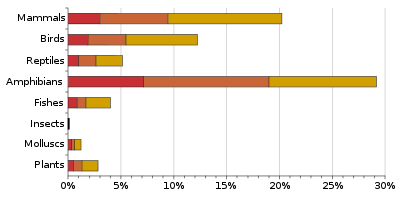The conservation status of a group of organisms (for instance, a species) indicates whether the group still exist (that is, members of it are still alive) and how likely the group is to become extinct in the near future. Many factors are taken into account when assessing conservation status: not simply the number of individuals remaining, but the overall increase or decrease in the population over time, breeding success rates, known threats, and so on.
The IUCN Red List of Threatened Species is the best-known worldwide conservation status listing and ranking system. The system divides threatened species into three categories: Critically Endangered (CR), Endangered (EN), and Vulnerable (VU)
Conservation status by risk of extinction
 Extinct
Extinct
Extinct
Extinct
Extinct in the wild
 Threatened
Threatened
Critically endangered
Endangered
Vulnerable
 At lower risk
At lower risk
Conservation dependent
Near threatened
Least concern

THE RED DATA LIST
The IUCN Red List of Threatened Species (also known as the IUCN Red List or Red Data List), founded in 1963, is the world's most comprehensive inventory of the global conservation status of biological species. The International Union for Conservation of Nature (IUCN) is the world's main authority on the conservation status of species. A series of Regional Red Lists are produced by countries or organizations, which assess the risk of extinction to species within a political management unit.
 The percentage of species in several groups which are listed as critically endangered, endangered, or vulnerable on the 2007 IUCN Red List.
The percentage of species in several groups which are listed as critically endangered, endangered, or vulnerable on the 2007 IUCN Red List.
MORE DETAILS---- IUCN RED DATA LIST
The IUCN Red List of Threatened Species is the best-known worldwide conservation status listing and ranking system. The system divides threatened species into three categories: Critically Endangered (CR), Endangered (EN), and Vulnerable (VU)
Conservation status by risk of extinction
Extinct in the wild
Critically endangered
Endangered
Vulnerable
Conservation dependent
Near threatened
Least concern

THE RED DATA LIST
The IUCN Red List of Threatened Species (also known as the IUCN Red List or Red Data List), founded in 1963, is the world's most comprehensive inventory of the global conservation status of biological species. The International Union for Conservation of Nature (IUCN) is the world's main authority on the conservation status of species. A series of Regional Red Lists are produced by countries or organizations, which assess the risk of extinction to species within a political management unit.

MORE DETAILS---- IUCN RED DATA LIST

0 comments:
Post a Comment